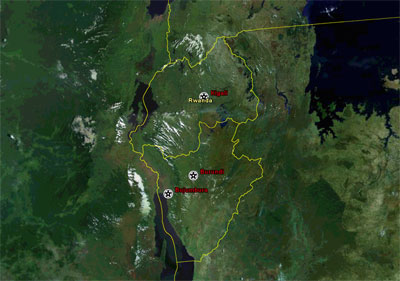RWANDA
Please note, this page is not longer being updated. For more recent information, please see news.mongabay.com and use the search function to find the country feed. For more up-to-date data on forest cover and loss, check out Global Forest Watch.
| Rwanda Forest Figures
Forest Cover Total forest area: 480,000 ha % of land area: 19.5% Primary forest cover: n/a % of land area: 0.0% % total forest area: n/a Deforestation Rates, 2000-2005 Annual change in forest cover: 27,200 ha Annual deforestation rate: 6.9% Change in defor. rate since '90s: 867.1% Total forest loss since 1990: 162,000 ha Total forest loss since 1990:50.9% Primary or "Old-growth" forests Annual loss of primary forests: n/a Annual deforestation rate: n/a Change in deforestation rate since '90s: n/a Primary forest loss since 1990: n/a Primary forest loss since 1990:n/a Forest Classification Public: 77% Private: 23% Other: 0% Use Production: 76.2% Protection: 10.8% Conservation: 0% Social services: 0% Multiple purpose: 12.9% None or unknown: 0 Forest Area Breakdown Total area: 480,000 ha Primary: n/a Modified natural: 62,000 ha Semi-natural: n/a Production plantation: 367,000 ha Production plantation: 52,000 ha Plantations Plantations, 2005: 419,000 ha % of total forest cover: 87.2% Annual change rate (00-05): 27,220,000 ha Carbon storage Above-ground biomass: 75 M t Below-ground biomass: 13 M t Area annually affected by Fire: 4,000 ha Insects: n/a Diseases: n/a Number of tree species in IUCN red list Number of native tree species: 300 Critically endangered: 0 Endangered: 0 Vulnerable: 3 Wood removal 2005 Industrial roundwood: 226,000 m3 o.b. Wood fuel: 10,203,000 m3 o.b. Value of forest products, 2005 Industrial roundwood: $1,318,000 Wood fuel: $33,977,000 Non-wood forest products (NWFPs): n/a Total Value: $35,295,000 More forest statistics for Rwanda |
Up until the early 1990s, this conservation system seemed to be working reasonably well, although non-park areas were still threatened by subsistence agriculture and fuelwood collection. However, the situation deteriorated drastically with the massive Tutsi-Hutu civil war that erupted in 1993. Although the chaos initially did not do much damage to the forest or the gorilla habitat, the mass exodus of hundreds of thousands of refugees took its toll on the environment. Many conservation workers fled their posts or were killed during the ethnic violence, while soldiers and refugees moved into national parks, hunting wildlife and razing forests for fuelwood and building materials. Akagera National Park was hit particularly hard.
All was not lost though. In the Nyungwe Forest Conservation Project, participation by locals sustained conservation projects even as the genocide occurred. According to Fimbel and Fimbel (1997), local people became stewards of the national park after the expatriate staff fled the country and protected the park from forest exploiters.
Today forest covers nearly 20 percent of Rwanda. While virtually none of this is classified as primary forest, a large reforestation effort increased overall forest cover by an average of 8 percent per year between 2000 and 2005. Currently about 7.7 percent of the country is under some form of protection. Rwanda's best known parks are Nyungwe National Park, Volcanoes National Park (montane forest harboring mountain gorillas and golden monkeys), and Akagera National Park (largest remaining lower montane forest on the continent of Africa).
Besides its world-renowned mountain gorilla population, Rwanda is home to 96 other species of mammals along with 665 birds, 31 amphibians, 206 reptiles, and 2,288 species of plants.
According to the U.S. Department of State, the Rwanda Defense Forces (RDF) currently provides security for tourists in the Volcanoes National Park against attacks by rebel groups operating from the neighboring Democratic Republic of the Congo. The RDF also provides military escorts for visitors viewing the mountain gorillas.
Recent articles | Rwanda news updates | XML
Suggested reading - Books
- Bradt Travel Guide Rwanda
- We Wish to Inform You That Tomorrow We Will be Killed With Our Families: Stories from Rwanda
- Field Guide to the Reptiles of East Africa: All the Reptiles of Kenya, Tanzania, Uganda, Rwanda and Burundi
- Tanzania, Rwanda and Burundi Map
- The Kingdon Pocket Guide to African Mammals
- Birds of Africa South of the Sahara
- Birds of Western and Central Africa
- Field Guide to the Birds of East Africa: Kenya, Tanzania, Uganda, Rwanda, Burundi
Unless otherwise specified, this article was written by Rhett A. Butler [Bibliographic citation for this page]
Other resources
Contact me if you have suggestions on other rainforest-related environmental sites and resources for this country.

Image copyright Google Earth, MDA EarthSet, DigitalGlobe 2005
CIA-World Factbook Profile
FAO-Forestry Profile
World Resources Institute
Last updated: 4 Feb 2006
